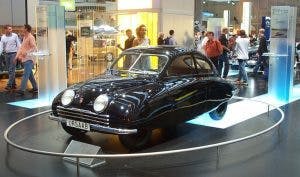The acronym SAAB was derived from the company name Svenska Aero AB, i.e. the Swedish Airplane Inc. From 1941 onwards, the company has designed and built a string of increasingly sophisticated military and civil aircraft, unmanned vehicles, missiles, as well as Naval communication and radar systems.
SAAB AUTOMOBILES
A first, hand-built prototype named 92.001 was presented in 1946. In December 1949, the first Saab 92 left the assembly line in the company’s airplane factory in Trollhättan, Sweden.
The new car had inherited several novel concepts from its airborne ancestors. From the aerodynamic shape and shell-like construction and to a whole-hearted focus on safety.
Compared to many other cars, Saabs were known to be somewhat underpowered. So, in 1959 Saab’s engineers unconventionally installed two standard cross-mounted 748 cc two-stroke engines. Soon thereafter, a record speed of 196 kilometers per hour was set at the local airport.
In the early 1970s, Saab also pioneered safety/convenience features such as headlamp wipers and electrically heated seats and, in the mid 1970s, the Saab turbo.
APC (Automatic Performance Control) was developed to handle variations in petrol quality so you could fuel virtually anything between 93 and 98 octane petrol.
These are just a few examples of Saab’s creative engineering.
Between 1968 and 1995 the company was merged with truck maker Scania under the company name Saab-Scania, but that’s another story.
RALLY CHAMPION
With ten wins at the prestigious Rally Sweden, Saab became the most successful brand ever. And the odd two-stroke Saab won the legendary Monte Carlo Rally with Erik Carlsson — a “moon-faced 250-lb Swede,” as Autoweek’s correspondent Jean Dupont deemed him — at the wheel. The next year, he and the 841-cc chainsaw-on-wheels repeated the feat, all despite treacherous roads that helped knock 196 of the 296 entrants out of the running.
So, what went wrong? Why did the company file for bankruptcy ten years ago, in December 2011?

DOWNWARDS SPIRAL
In the words of Motortrend, “Saab made a series of poorly considered financial decisions that, combined with market realities, pulled the company into GM’s orbit in 1989. By the end of the 1990s, it had become a fully captive subsidiary of GM, its future entirely dependent on Detroit-based bean counters, and by the 2010s, it was all but completely gone.”
Sold by GM, the company sadly continued its unworthy downwards spiral featuring (among other things) a small Dutch sports car maker, Chinese investors, and another bankruptcy in 2014.
